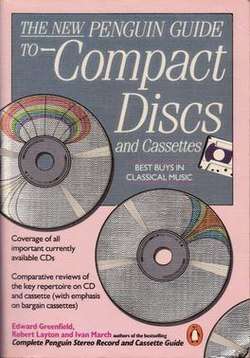The Penguin Guide to Recorded Classical Music

The Penguin Guide to Recorded Classical Music (formerly The Penguin Guide to Compact Discs and, from 2003 to 2006, The Penguin Guide to Compact Discs and DVDs) was a widely distributed annual publication from Britain published by Penguin Books that reviewed and rated currently available recordings of classical music. It was written by Ivan March, a music journalist, consultant and former professional musician; Edward Greenfield, former music critic of The Guardian newspaper and Robert Layton, music writer and lecturer. All three were also reviewers for the UK classical music periodical Gramophone. From 2008-2010, a fourth contributor was listed also as a co-author, Paul Czajkowski, who had been listed an editor from the 2002 book.
The Guide was often found in the classical departments of record stores. In earlier editions, the Guide awarded each recording a rating of between one and three stars, with extraordinarily favoured recordings receiving a rosette. From 2007-2010, the publication used four stars to denote records which are "exceptional issue[s] on every count". DVDs of operas and classical music concerts and Super Audio Compact Discs were also reviewed.
Ratings
As provided by The Penguin Guide To Recorded Classical Music:
- Rosette: A rosette is a compliment that places the recording in a very special class.
- 4 Stars: A very exceptional issue on every count.
- 3 Stars: An outstanding performance and recording of the calibre we now take for granted.
- 2 Stars: A good performance and recording of today's normal high standard.
- 1 Star: A fair or somewhat routine performance, reasonably well performed or recorded.
NOTE: A star in brackets means there is some qualification to the performance or recording. A bracket around all three stars usually denotes an outstanding performance in dated monaural sound.
History
The guidebook first appeared in 1960 as The Stereo Record Guide, in response to the increasing number of stereo LP recordings available. Up to 1968 the writing team comprised Ivan March, Edward Greenfield and Denis Stevens. Penguin Books, having published guides to bargain records (1966, 1970 and 1972), began publishing the guides in 1975. In those days, as the reviewers concede[1] it was possible to include almost all stereo recordings, so limited was the repertoire.
Additional volumes were printed to cover cassettes, and in the 1984 Guide compact discs were added for the first time. By the 1990 revision so completely had CDs come to dominate that LPs were omitted altogether. Since 1997, the main guide was supplemented by alternately published 'yearbooks', adding new recordings and recommended issues for that particular year. Several other supplementary volumes were released covering 'bargain' recordings. Additionally, after 2003, classical music DVDs were incorporated, initially as an appendix, but, from the 2006 edition, in the main body of the reviews themselves.
Whilst these other volumes added further reviews, the authors admitted[2] that attempting to cover all releases was impossible, and instead only the 'cream' of available recordings could be covered.
This more selective approach, coupled with a perceived British bias, led to criticism, on internet newsgroups and elsewhere. However, as even some critics agreed[3] a project on this scale and on this topic (inevitably a subjective affair) could not have been expected to suit all perspectives.
The final edition of the Guide was the 2010 edition, published in November, 2009. Subsequently, for two years, the authors collaborated on a Penguin Guide to the 1000 Finest Classical Recordings: The Must-Have CDs and DVDs, less authoritative than the previous Guide and less than half its length.[4] No related publication has been issued since September, 2012.
References
- ↑ 2006 Penguin Guide, p. vii
- ↑ 2006 Penguin Guide, p. xi
- ↑ Review of 2004 edition
- ↑ The Classical Music Guide Forums: Penguin Guide: Is This What It's Come To?
External links
- Review of the 2008 edition
- Review of the 2004 edition
- Interview with the reviewers
- A review of the 1997/98 edition at The Inkpot